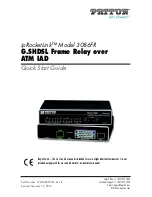
DES-30XX Layer 2 Switch CLI Reference Manual
47
7
SMTP
C
OMMANDS
SMTP or Simple Mail Transfer Protocol is a function of the Switch that will send switch events to mail recipients based on e-
mail addresses entered using the commands below. The Switch is to be configured as a client of SMTP while the server is a
remote device that will receive messages from the Switch, place the appropriate information into an e-mail and deliver it to
recipients configured on the Switch. This can benefit the Switch administrator by simplifying the management of small
workgroups or wiring closets, increasing the speed of handling emergency Switch events and enhancing security by recording
questionable events occurring on the Switch.
The Switch plays four important roles as a client in the functioning of SMTP:
•
The server and server virtual port must be correctly configured for this function to work properly. This is accomplished
in the
config smtp
command by properly configuring the
server
and
server_port
parameters.
•
Mail recipients must be configured on the Switch. This information is sent to the server which then processes the
information and then e-mails Switch information to these recipients. Up to 8 e-mail recipients can be configured on the
Switch using the
config smtp
command by configuring the
add mail_receiver
and
delete mail_receiver
parameters.
•
The administrator can configure the source mail address from which messages are delivered to configured recipients.
This can offer more information to the administrator about Switch functions and problems. The personal e-mail can be
configured using the
config smtp
command and setting the
self_mail_addr
parameter.
•
The Switch can be configured to send out test mail to first ensure that the recipient will receive e-mails from the SMTP
server regarding the Switch. To configure this test mail, the SMTP function must first be enabled using the
enable smtp
command and then by entering the
smtp send_testmsg
command. All recipients configured for SMTP will receive a
sample test message from the SMTP server, ensuring the reliability of this function.
The Switch will send out e-mail to recipients when one or more of the following events occur:
•
When a cold start occurs on the Switch.
•
When a port enters a link down status.
•
When a port enters a link up status.
•
When SNMP authentication has been denied by the Switch.
•
When a switch configuration entry has been saved to the NVRAM by the Switch.
•
When an abnormality occurs on TFTP during a firmware download event. This includes
in-process
,
invalid-file
,
violation
,
file-not-found
,
complete
and
time-out
messages from the TFTP server.
•
When a system reset occurs on the Switch.
Information within the e-mail from the SMTP server regarding switch events includes:
•
The source device name and IP address.
•
A timestamp denoting the identity of the SMTP server and the client that sent the message, as well as the time and date
of the message received from the Switch. Messages that have been relayed will have timestamps for each relay.
•
The event that occurred on the Switch, prompting the e-mail message to be sent.
•
When an event is processed by a user, such as save or firmware upgrade, the IP address, MAC address and User Name
of the user completing the task will be sent along with the system message of the event occurred.
•
When the same event occurs more than once, the second mail message and every repeating mail message following will
have the system’s error message placed in the subject line of the mail message.
The following details events occurring during the Delivery Process.
•
Urgent mail will have high priority and be immediately dispatched to recipients while normal mail will be placed in a
queue for future transmission.
•
The maximum number of untransmitted mail messages placed in the queue cannot exceed 30 messages. Any new
messages will be discarded if the queue is full.
















































